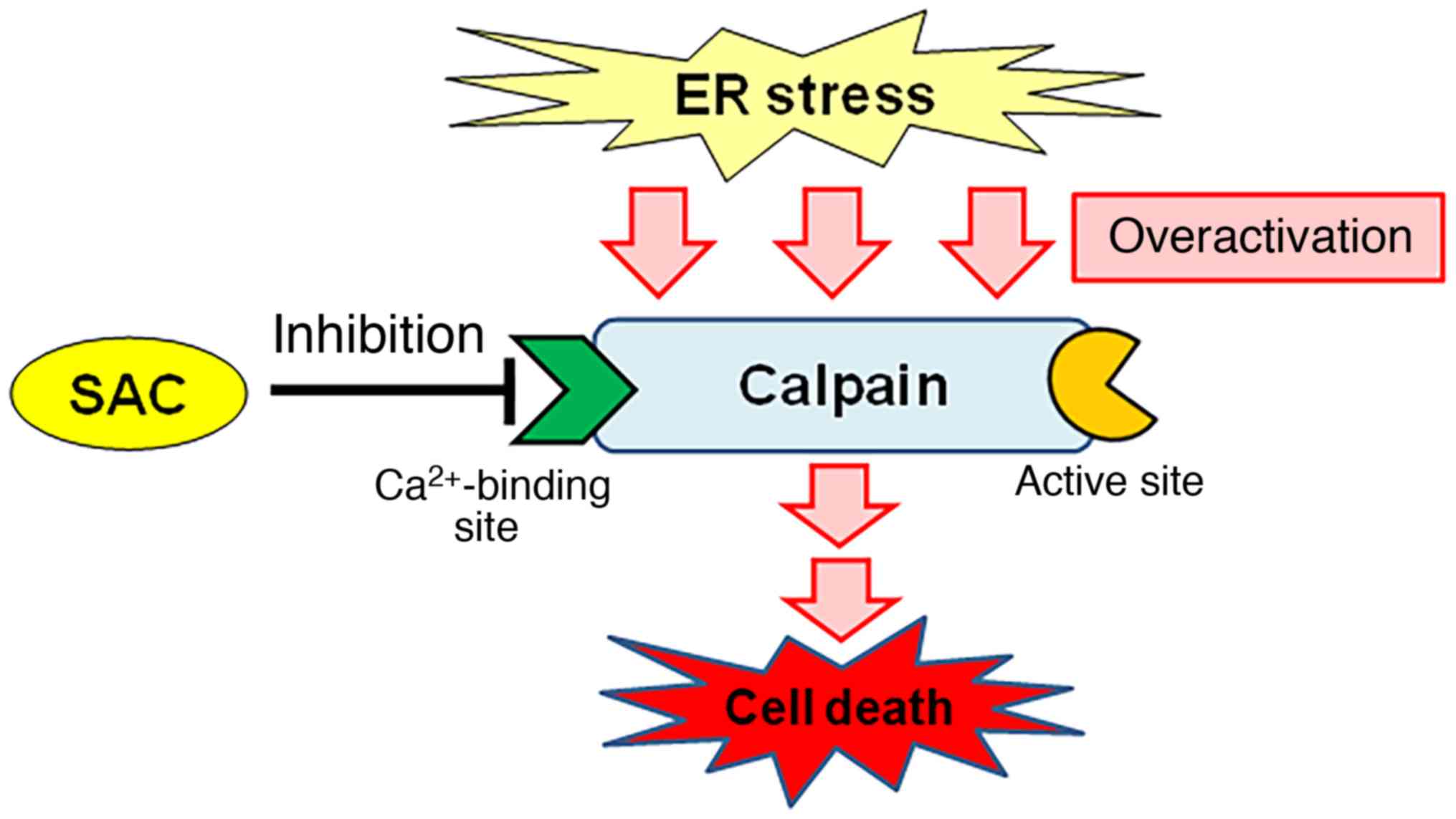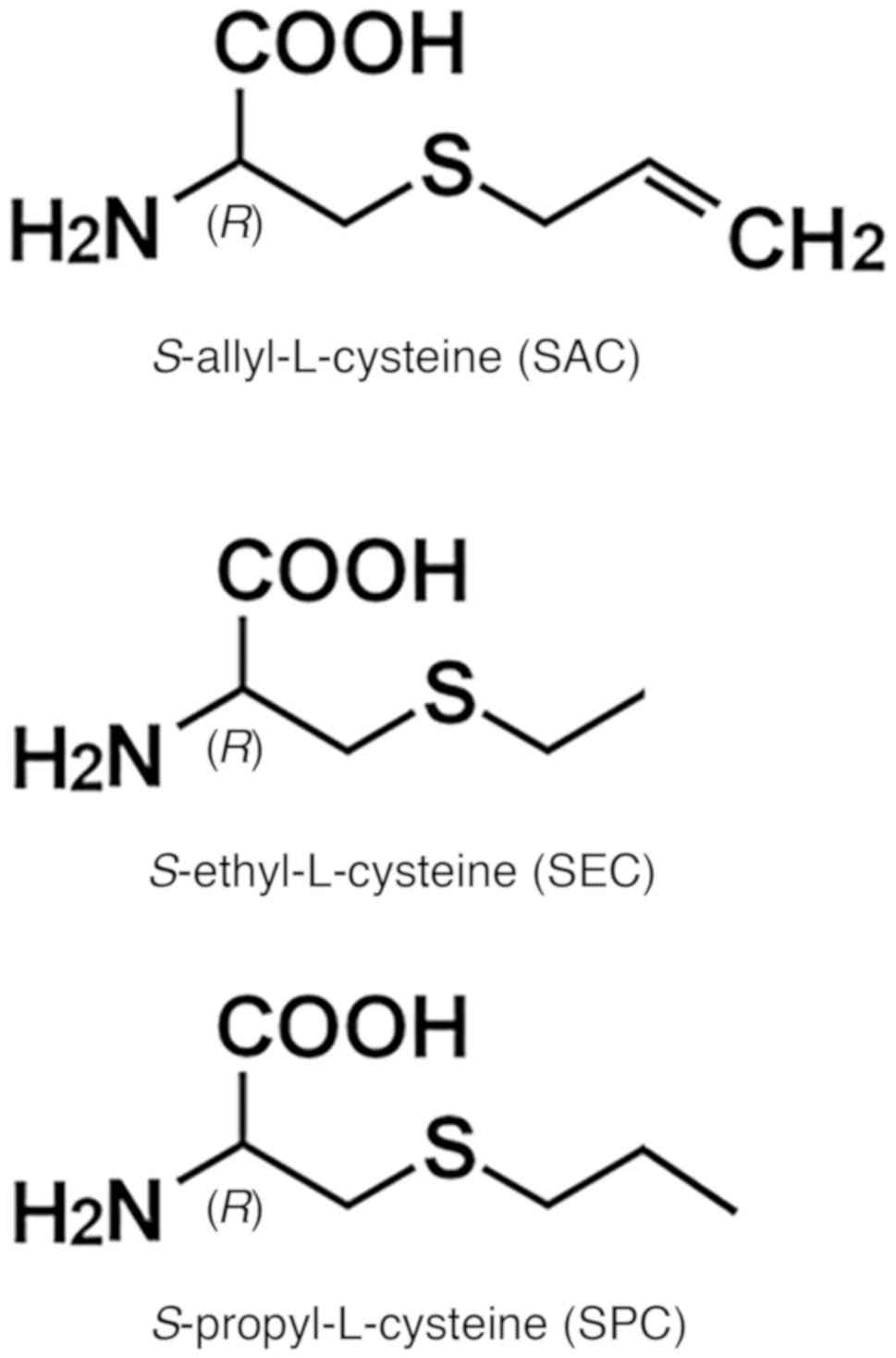|
1
|
Colín-González AL, Santana RA, Silva-Islas
CA, Chánez-Cárdenas ME, Santamaría A and Maldonado PD: The
antioxidant mechanisms underlying the aged garlic extract- and
S-allylcysteine-induced protection. Oxid Med Cell Longev.
2012:9071622012. View Article : Google Scholar : PubMed/NCBI
|
|
2
|
Saravanan G and Ponmurugan P: Antidiabetic
effect of S-allylcysteine: Effect on thyroid hormone and
circulatory antioxidant system in experimental diabetic rats. J
Diabetes Complications. 26:280–285. 2012. View Article : Google Scholar : PubMed/NCBI
|
|
3
|
Yeh YY and Liu L: Cholesterol-lowering
effect of garlic extracts and organosulfur compounds: Human and
animal studies. J Nutr. 131 (Suppl 3):989S–993S. 2001. View Article : Google Scholar : PubMed/NCBI
|
|
4
|
Thomson M and Ali M: Garlic [Allium
sativum]: A review of its potential use as an anti-cancer
agent. Curr Cancer Drug Targets. 3:67–81. 2003. View Article : Google Scholar : PubMed/NCBI
|
|
5
|
Kodai S, Takemura S, Minamiyama Y, Hai S,
Yamamoto S, Kubo S, Yoshida Y, Niki E, Okada S, Hirohashi K, et al:
S-allyl cysteine prevents CCl(4)-induced acute liver injury
in rats. Free Radic Res. 41:489–497. 2007. View Article : Google Scholar : PubMed/NCBI
|
|
6
|
Moriguchi T, Matsuura H, Kodera Y, Itakura
Y, Katsuki H, Saito H and Nishiyama N: Neurotrophic activity of
organosulfur compounds having a thioallyl group on cultured rat
hippocampal neurons. Neurochem Res. 22:1449–1452. 1997. View Article : Google Scholar : PubMed/NCBI
|
|
7
|
Nishiyama N, Moriguchi T, Morihara N and
Saito H: Ameliorative effect of S-allylcysteine, a major
thioallyl constituent in aged garlic extract, on learning deficits
in senescence-accelerated mice. J Nutr. 131 (Suppl 3):1093S–1095S.
2001. View Article : Google Scholar : PubMed/NCBI
|
|
8
|
Baluchnejadmojarad T, Kiasalari Z,
Afshin-Majd S, Ghasemi Z and Roghani M: S-allyl cysteine
ameliorates cognitive deficits in streptozotocin-diabetic rats via
suppression of oxidative stress, inflammation, and
acetylcholinesterase. Eur J Pharmacol. 794:69–76. 2017. View Article : Google Scholar : PubMed/NCBI
|
|
9
|
Paschen W: Endoplasmic reticulum: A
primary target in various acute disorders and degenerative diseases
of the brain. Cell Calcium. 34:365–383. 2003. View Article : Google Scholar : PubMed/NCBI
|
|
10
|
Placido AI, Pereira CM, Duarte AI,
Candeias E, Correia SC, Carvalho C, Cardoso S, Oliveira CR and
Moreira PI: Modulation of endoplasmic reticulum stress: An
opportunity to prevent neurodegeneration? CNS Neurol Disord Drug
Targets. 14:518–533. 2015. View Article : Google Scholar : PubMed/NCBI
|
|
11
|
Schröder M and Kaufman RJ: The mammalian
unfolded protein response. Annu Rev Biochem. 74:739–789. 2005.
View Article : Google Scholar : PubMed/NCBI
|
|
12
|
Gorman AM, Healy SJ, Jäger R and Samali A:
Stress management at the ER: Regulators of ER stress-induced
apoptosis. Pharmacol Ther. 134:306–316. 2012. View Article : Google Scholar : PubMed/NCBI
|
|
13
|
Nakagawa T and Yuan J: Cross-talk between
two cysteine protease families. Activation of caspase-12 by calpain
in apoptosis. J Cell Biol. 150:887–894. 2000. View Article : Google Scholar : PubMed/NCBI
|
|
14
|
Nakagawa T, Zhu H, Morishima N, Li E, Xu
J, Yankner BA and Yuan J: Caspase-12 mediates
endoplasmic-reticulum-specific apoptosis and cytotoxicity by
amyloid-beta. Nature. 403:98–103. 2000. View Article : Google Scholar : PubMed/NCBI
|
|
15
|
Kosuge Y, Koen Y, Ishige K, Minami K,
Urasawa H, Saito H and Ito Y: S-allyl-L-cysteine selectively
protects cultured rat hippocampal neurons from amyloid
beta-protein- and tunicamycin-induced neuronal death. Neuroscience.
122:885–895. 2003. View Article : Google Scholar : PubMed/NCBI
|
|
16
|
Kosuge Y, Sakikubo T, Ishige K and Ito Y:
Comparative study of endoplasmic reticulum stress-induced neuronal
death in rat cultured hippocampal and cerebellar granule neurons.
Neurochem Int. 49:285–293. 2006. View Article : Google Scholar : PubMed/NCBI
|
|
17
|
Imai T, Kosuge Y, Ishige K and Ito Y:
Amyloid beta-protein potentiates tunicamycin-induced neuronal death
in organotypic hippocampal slice cultures. Neuroscience.
147:639–651. 2007. View Article : Google Scholar : PubMed/NCBI
|
|
18
|
Kosuge Y, Imai T, Kawaguchi M, Kihara T,
Ishige K and Ito Y: Subregion-specific vulnerability to endoplasmic
reticulum stress-induced neurotoxicity in rat hippocampal neurons.
Neurochem Int. 52:1204–1211. 2008. View Article : Google Scholar : PubMed/NCBI
|
|
19
|
Ito Y, Kosuge Y, Sakikubo T, Horie K,
Ishikawa N, Obokata N, Yokoyama E, Yamashina K, Yamamoto M, Saito
H, et al: Protective effect of S-allyl-L-cysteine, a garlic
compound, on amyloid beta-protein-induced cell death in nerve
growth factor-differentiated PC12 cells. Neurosci Res. 46:119–125.
2003. View Article : Google Scholar : PubMed/NCBI
|
|
20
|
Imai T, Kosuge Y, Endo-Umeda K, Miyagishi
H, Ishige K, Makishima M and Ito Y: Protective effect of
S-allyl-L-cysteine against endoplasmic reticulum
stress-induced neuronal death is mediated by inhibition of calpain.
Amino Acids. 46:385–393. 2014. View Article : Google Scholar : PubMed/NCBI
|
|
21
|
Yoneda T, Imaizumi K, Oono K, Yui D, Gomi
F, Katayama T and Tohyama M: Activation of caspase-12, an
endoplastic reticulum (ER) resident caspase, through tumor necrosis
factor receptor-associated factor 2-dependent mechanism in response
to the ER stress. J Biol Chem. 276:13935–13940. 2001. View Article : Google Scholar : PubMed/NCBI
|
|
22
|
Rao RV, Hermel E, Castro-Obregon S, del
Rio G, Ellerby LM, Ellerby HM and Bredesen DE: Coupling endoplasmic
reticulum stress to the cell death program. Mechanism of caspase
activation. J Biol Chem. 276:33869–33874. 2001. View Article : Google Scholar : PubMed/NCBI
|
|
23
|
Tan Y, Dourdin N, Wu C, De Veyra T, Elce
JS and Greer PA: Ubiquitous calpains promote caspase-12 and JNK
activation during endoplasmic reticulum stress-induced apoptosis. J
Biol Chem. 281:16016–16024. 2006. View Article : Google Scholar : PubMed/NCBI
|
|
24
|
Muruganandan S and Cribb AE:
Calpain-induced endoplasmic reticulum stress and cell death
following cytotoxic damage to renal cells. Toxicol Sci. 94:118–128.
2006. View Article : Google Scholar : PubMed/NCBI
|
|
25
|
Carragher NO: Calpain inhibition: A
therapeutic strategy targeting multiple disease states. Curr Pharm
Des. 12:615–638. 2006. View Article : Google Scholar : PubMed/NCBI
|
|
26
|
Wang KK, Nath R, Posner A, Raser KJ,
Buroker-Kilgore M, Hajimohammadreza I, Probert AW Jr, Marcoux FW,
Ye Q, Takano E, et al: An alpha-mercaptoacrylic acid derivative is
a selective nonpeptide cell-permeable calpain inhibitor and is
neuroprotective. Proc Natl Acad Sci USA. 93:6687–6692. 1996.
View Article : Google Scholar : PubMed/NCBI
|
|
27
|
Jones MG, Hughes J, Tregova A, Milne J,
Tomsett AB and Collin HA: Biosynthesis of the flavour precursors of
onion and garlic. J Exp Bot. 55:1903–1918. 2004. View Article : Google Scholar : PubMed/NCBI
|
|
28
|
Imai T, Kosuge Y, Saito H, Uchiyama T,
Wada T, Shimba S, Ishige K, Miyairi S, Makishima M and Ito Y:
Neuroprotective effect of S-allyl-l-cysteine derivatives
against endoplasmic reticulum stress-induced cytotoxicity is
independent of calpain inhibition. J Pharmacol Sci. 130:185–188.
2016. View Article : Google Scholar : PubMed/NCBI
|
|
29
|
Amano H, Kazamori D and Itoh K:
Pharmacokinetics of S-Allyl-l-cysteine in rats is
characterized by high oral absorption and extensive renal
reabsorption. J Nutr. 146:456S–459S. 2016. View Article : Google Scholar : PubMed/NCBI
|
|
30
|
Ried K, Frank OR and Stocks NP: Aged
garlic extract lowers blood pressure in patients with treated but
uncontrolled hypertension: A randomised controlled trial.
Maturitas. 67:144–150. 2010. View Article : Google Scholar : PubMed/NCBI
|
|
31
|
Atif F, Yousuf S and Agrawal SK:
S-allyl L-cysteine diminishes cerebral ischemia-induced
mitochondrial dysfunctions in hippocampus. Brain Res. 1265:128–137.
2009. View Article : Google Scholar : PubMed/NCBI
|
|
32
|
Ray B, Chauhan NB and Lahiri DK: Oxidative
insults to neurons and synapse are prevented by aged garlic extract
and S-allyl-L-cysteine treatment in the neuronal culture and
APP-Tg mouse model. J Neurochem. 117:388–402. 2011. View Article : Google Scholar : PubMed/NCBI
|
|
33
|
Chauhan NB: Effect of aged garlic extract
on APP processing and tau phosphorylation in Alzheimer's transgenic
model Tg2576. J Ethnopharmacol. 108:385–394. 2006. View Article : Google Scholar : PubMed/NCBI
|
|
34
|
Tsai SJ, Chiu CP, Yang HT and Yin MC:
S-allyl cysteine, S-ethyl cysteine, and
S-propyl cysteine alleviate β-amyloid, glycative, and
oxidative injury in brain of mice treated by D-galactose. J Agric
Food Chem. 59:6319–6326. 2011. View Article : Google Scholar : PubMed/NCBI
|
|
35
|
Chen CM, Yin MC, Hsu CC and Liu TC:
Antioxidative and anti-inflammatory effects of four
cysteine-containing agents in striatum of MPTP-treated mice.
Nutrition. 23:589–597. 2007. View Article : Google Scholar : PubMed/NCBI
|
|
36
|
García E, Santana-Martínez R, Silva-Islas
CA, Colín-González AL, Galván-Arzate S, Heras Y, Maldonado PD,
Sotelo J and Santamaría A: S-allyl cysteine protects against
MPTP-induced striatal and nigral oxidative neurotoxicity in mice:
Participation of Nrf2. Free Radic Res. 48:159–167. 2014. View Article : Google Scholar : PubMed/NCBI
|
|
37
|
Nakka VP, Prakash-Babu P and Vemuganti R:
Crosstalk between endoplasmic reticulum stress, oxidative stress,
and autophagy: potential therapeutic targets for acute CNS
injuries. Mol Neurobiol. 53:532–544. 2016. View Article : Google Scholar : PubMed/NCBI
|
















